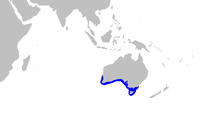Longnose sawshark
| Longnose sawshark | |
|---|---|
_Saw_shark_-_William_Buelow_Gould%2C_c1832.jpg) | |
| Pristiophorus cirratus, from the Sketchbook of fishes by William Buelow Gould, 1832 | |
| Scientific classification | |
| Kingdom: | Animalia |
| Phylum: | Chordata |
| Class: | Chondrichthyes |
| Subclass: | Elasmobranchii |
| Order: | Pristiophoriformes |
| Family: | Pristiophoridae |
| Genus: | Pristiophorus |
| Species: | P. cirratus |
| Binomial name | |
| Pristiophorus cirratus (Latham, 1794) | |
 | |
| Range of longnose sawshark (in blue) | |
The longnose sawshark, Pristiophorus cirratus, also known as the common sawshark is a sawshark of the family Pristiophoridae. This shark is large and stocky for a sawshark. It also has a very long rostrum, which can take up to 30% of its total body length. The longnose sawshark has pale yellow or grayish-brown dorsal coloring and white ventral coloring. Variegated, sometimes faint dark blotches, spots, and bars cover its back. The barbels of the longnose sawshark are halfway down the rostrum, but slightly closer to the rostral tip than the nostrils. Its maximum length is up to 1.37 m (4 ft 6 in).[2]
Range and Habitat
The longnose sawshark is found in the eastern Indian Ocean around southern Australia and Tasmania on the continental shelf at depths of 40–310 m (130–1,020 ft). While they may venture into bays and estuaries on occasion, longnose sawsharks prefer sandy and gravelly areas offshore between 37–146 m (121–479 ft).[3]
Behavior
Somewhat unusually, the longnose sawshark forms schools. These schools are thought to possibly be feeding aggregates, where the sharks hunt en masse for prey. The known prey of this shark include small fishes and crustaceans. This species of sawshark is ovoviviparous. They give birth every other winter to between 6 and 19 pups in each litter. The pups are born with their teeth folded against their snout which protects the mother from harm. A new born pup is between 31–34 cm (12–13 in) long. Longnose sawsharks are highly productive in comparison to other shark species, maturing quickly and only living for around 15 years.[4]
Conservation
The longnose sawshark is listed as Least Concern by the IUCN Red List. They used to be listed as Near Threatened, but data gathered after 2000 ultimately led to the new classification. These sharks are highly productive and are protected by laws that keep the catch rate of them stable. Large tracts of their range are protected from all shark fishing, helping to buffer their population loss tremendously. The meat of this shark is fairly popular in Australia and is said to have an excellent taste. Because of its deep habitat and overall behavior, the longnose sawshark is not a threat to humans.[5]
References
- ↑ Walker, T.I. & Simpfendorfer, C. (SSG Australia & Oceania Regional Workshop, March 2003) (2003). "Pristiophorus cirratus". IUCN Red List of Threatened Species. Version 2012.2. International Union for Conservation of Nature. Retrieved 2013-01-20.
- ↑ Froese, Rainer and Pauly, Daniel, eds. (2006). "Pristiophorus cirratus" in FishBase. May 2006 version.
- ↑ Compagno, Leonardo, Dando, Marc and Fowler, Sarah. Sharks of the World. Princeton University Press. 2005. pg 132.
- ↑ http://species-identification.org/species.php?species_group=sharks&id=225
- ↑ http://www.iucnredlist.org/details/39327/0
External links
| Wikimedia Commons has media related to Pristiophorus cirratus. |
- Longnose Sawshark - Profile and Photos
- Pristiophorus cirratus at shark-references.com
